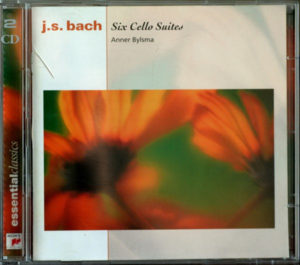
Anna Bylsma.
Anner Bylsma Bach Cello Suites. Sony Classical SB2K60880 Release year 1999
Recorded at the Church in Eching, Bavaria, Germany during April and May 1979.
This edition is remastered using “20 bit technology to maximise sound quality.”
Cellos used were Mattio Goffriller, Venice 1669 and for the 6thSuite a Violoncello piccolo from South Tyrol ca. 1700.
General comments.
Bylsma has made two recordings of the Bach Cello Suites. The second is quite a contrast to this first recording and I hope to review that soon.
This recording, originally from 1977 is considered to be one of the first if not the first recording of the Bach solo cello Suites to present this music in as close to the original style as possible. This meant using original instruments of Bach’s period, gut strings, baroque bow held much further away from the frog of the bow, and positioning the cello with no end pin. One then needs to consider the style and interpretation. Rather than go into a long exposition about matters I have only a superficial knowledge of I would encourage the interested reader to check out this web site:
The most striking impression of this particular recording is the quality of the cello tone. It does strike me as quite nasal and in some areas “raspy.” Having listened to a number of more recent Baroque style recordings, I am confident this is not simply the effect of using period instrument and bow. I emphasise that this is my only significant criticism, but since it is obvious from the onset I feel I need to be upfront with this.
Having listened to later You Tube recordings by Bylsma in his 80s, my impression is that this may be a feature of the recording. Moreover, in the case of this release, digital processing which some people including myself believe adds further glassiness to the CD sound. I am endeavouring to locate a reasonably priced vinyl version of this recording and will append a comment when I have had the opportunity to listen. Otherwise the acoustic is airy without excessive echo.
The Music.
In terms of interpretation, I feel there are a number of consistencies which can be described across the Suites.
The Preludes-
have scale and weight as befits their place as first movements. The Prelude of the fourth Suite stands out in that it is pretty rapid without significant emphasis on any part of the bar, which results in the movement sounding a little like a trotting horse. This I find rather appealing and different. The fifth Prelude impresses particularly in the fugue section which keeps momentum and flow throughout.
The Allemandes-
tend to be on the slower side with very detailed phrasing but can in some cases sound a little disjointed and not flow quite as well as some performances. A little romanticism seems to creep in at times.
The Courantes-
are usually performed at quite a steady pace and whilst keeping their dance rhythm are not the most dynamic parts of the Suites as performed by Bylsma.
The Sarabandes-
are noticeable by the lightness of double stopping and chords. Some of the lower notes are only touched to sound rather than held on for as long as in the case of other performances. This I find is attractive to listen to in that it preserves the dance nature of the movement and helps the piece to flow.
The Gavottes and Bourees-
are mostly brisk and rhythmic.
The Gigues-
I felt were the most exciting movements, the second particularly having a very strong attack, conveying the impression of swords crossing, the bow work being so crisp and snappy.
I do feel in general that there is not much in the way of dynamics. By this, I mean contrast between soft and loud passages. This is easier to achieve with modern instrumentation but other baroque performers have managed to impress in this area.
Conclusion.
In summary, I feel Bylsma deserves immense respect for leading the way with “authentic” interpretation of the Bach Cello Suites. I would suggest that others have taken his lead and developed the process further and with greater effect.
Charles.